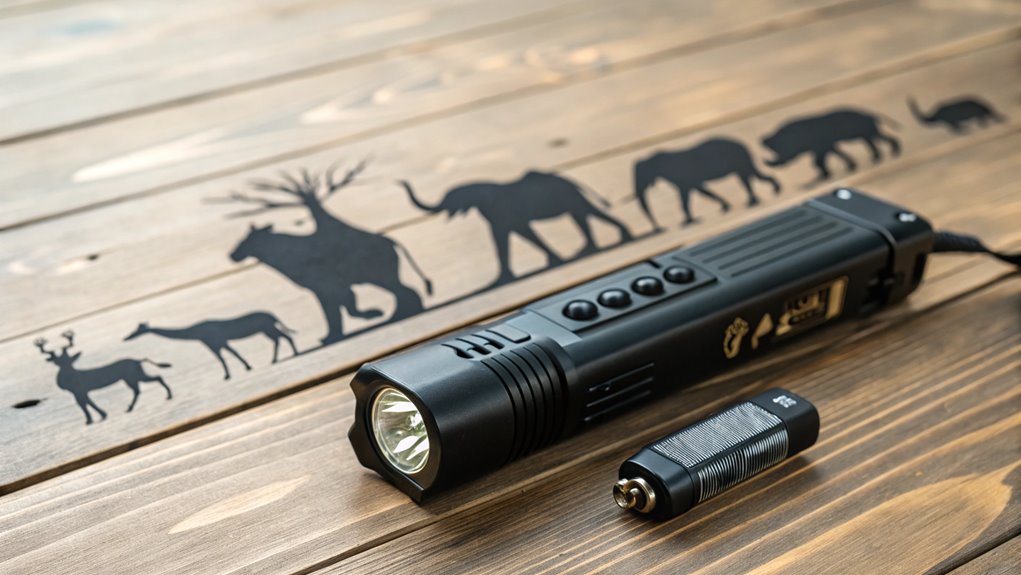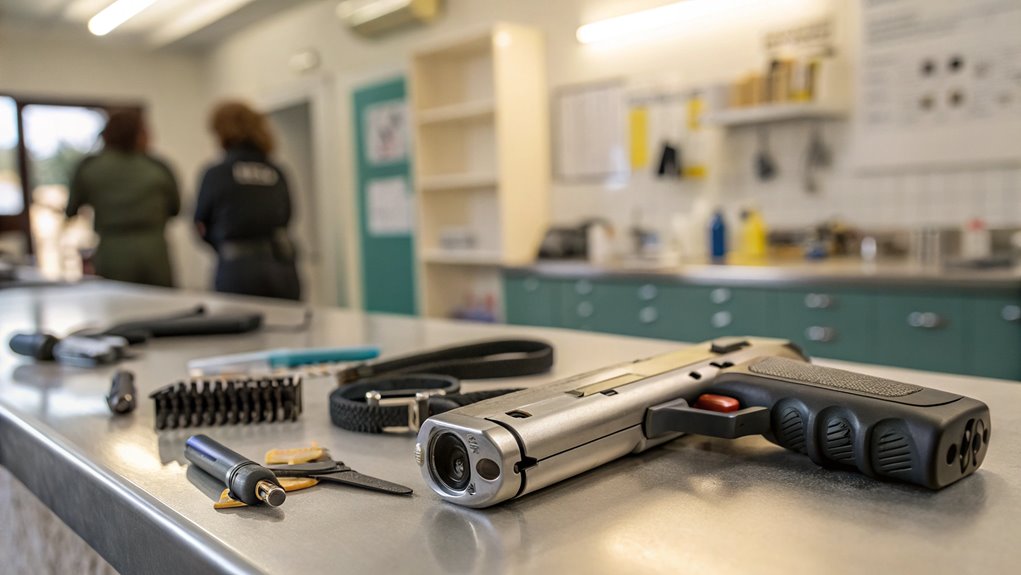Using stun guns on animals isn't safe or humane because they can cause serious physical harm like burns and even heart issues. Plus, animals can develop a fear of humans or become more aggressive. The effects can last a whole 45 minutes! It's crucial to think about the animal's well-being and consider better options. You could use bear spray or loud air horns, which deter animals without causing harm. Experts suggest these alternatives because they keep everyone safe and respect animal rights. To understand more effective and compassionate methods, you might want to stick around for some helpful tips!
Understanding Stun Guns

A stun gun is a device designed to deliver a high-voltage shock to incapacitate an attacker or animal temporarily. These gadgets work using specific stun gun mechanisms that send an electric current through the body. When you press the trigger, the stun gun generates a powerful shock, affecting the nervous system and causing temporary immobilization. You might wonder how this interacts with animal physiology. Well, animals, much like humans, have a nervous system that can react to electrical impulses. When a stun gun is used, it disrupts the normal signals in an animal's body, making it lose control for a brief period. This can be vital in self-defense situations, especially if you're facing a threatening animal. One example of a stun gun is the 110,000,000 volt Bad Ass Metal Stun Baton, which also includes a flashlight feature for added utility. The 100 Million volt Bouncer Stun gun also offers similar features and has a rubberized handle for improved grip, ensuring secure handling during use. However, it's important to understand that while stun guns can help in emergencies, they should be used responsibly and only when absolutely necessary. You wouldn't want to harm an animal unnecessarily, and knowing how your stun gun works can help you make better choices.
Potential Risks to Animals
Using stun guns on animals can pose significant risks, both physically and psychologically. When you think about using one on an animal, you should consider how it might affect their well-being. For instance, animals might experience intense pain, fear, or confusion. These reactions can lead to serious safety concerns, not just for the animal but for you too. The effects can last up to 45 minutes, similar to those of pepper spray.
Here's a quick look at some potential risks:
| Physical Risks | Psychological Risks |
|---|---|
| Burns or tissue damage | Increased aggression |
| Heart problems in sensitive animals | Long-term fear of humans |
| Unpredictable reactions | Anxiety or stress disorders |
These factors can seriously impact animal welfare. If an animal feels threatened, it might act out in ways that could put you or others in danger. So, it's essential to weigh these risks carefully before deciding to use a stun gun. Always prioritize safety and think of alternative methods to handle animals without causing harm. Remember, a responsible approach to animal interactions is important for everyone's safety!
Ethical Considerations

Contemplating the potential risks to animals when using stun guns leads to important ethical questions. You might be wondering, is it really okay to use a device designed to incapacitate living beings, even if it's meant for protection?
It's vital to reflect on animal welfare and the ethical treatment of all creatures. Using stun guns on animals can cause pain and fear, which raises serious concerns about how we respect their lives and well-being.
Imagine if someone used a stun gun on your pet or a stray animal; you'd likely feel upset and concerned about their suffering. It's important to evaluate whether the potential benefits of using stun guns outweigh the harm they might cause.
While you may believe that using a stun gun can be an effective way to deter aggressive animals, you also have to think about the long-term impact on their physical and mental health.
In the end, you should weigh the ethical implications of your choices and explore other non-harmful options that prioritize animal welfare. Respecting and treating all living beings ethically should be at the forefront of any decision you make regarding self-defense tools.
Alternatives to Stun Guns
Exploring humane alternatives to stun guns opens up a range of options that prioritize both safety and animal welfare. If you're looking for ways to protect yourself without causing harm, consider humane methods like bear spray or air horns.
Bear spray is designed to deter aggressive animals without causing long-term damage, making it a great option for personal safety in the outdoors.
Another alternative is using a loud air horn. This can startle an animal and give you time to escape without inflicting pain.
Additionally, creating distance with barriers, such as fences or natural obstacles, can help you avoid dangerous encounters altogether.
Training your dog in obedience and socialization can also be effective. A well-trained pet is less likely to provoke aggressive situations, and you'll have better control in unpredictable scenarios.
Lastly, education is key. Learning about animal behavior helps you understand their reactions and how to respond appropriately.
Expert Opinions and Recommendations

When it comes to safety measures involving animals, expert opinions emphasize the importance of non-lethal options. Using stun guns on animals raises serious concerns about animal welfare and can lead to unintended consequences.
Experts recommend exploring alternatives that are safe, humane, and effective. For instance, using noise deterrents or pepper spray can often resolve conflicts without causing harm.
Moreover, you should consider the legal implications of using stun guns on animals. In many places, using such devices could land you in legal trouble or result in fines.
Animal rights organizations strongly advocate for humane treatment, and misusing a stun gun might be viewed as animal cruelty.
Experts urge you to think critically about your safety options and prioritize non-lethal methods. Learning to read animal behavior can help you avoid dangerous situations altogether.
Training in conflict resolution techniques can also empower you to handle encounters responsibly.
Answers to Common Questions
Are There Specific Animal Species That React Differently to Stun Guns?
Yes, specific animal species show varying species sensitivity to stun guns. You'll notice different behavioral reactions based on the animal's size, temperament, and neurological makeup, which can influence how they respond to electrical stimuli.
What Are the Legal Restrictions on Using Stun Guns on Animals?
You might think using stun guns on animals is straightforward, but it's not. Legal consequences can arise if you violate animal welfare laws, so always check your local regulations before considering any action involving stun guns.
Can Stun Guns Cause Long-Term Health Issues for Animals?
Using stun guns on animals can potentially lead to long-term effects that compromise animal welfare. You should consider the risks involved, as the impact on an animal's health might not be immediately visible or understood.
How Do Stun Guns Compare to Tranquilizers for Animal Control?
Imagine your beloved pet in distress. Stun guns offer immediate effectiveness, but tranquilizers guarantee safety and longer-lasting calm. You'll weigh the urgency of control against the potential risks to your animal's well-being. Choose wisely.
Are There Training Programs for Using Stun Guns on Animals?
Yes, there are training programs focusing on effective training techniques for using stun guns on animals. Understanding animal behavior is essential, as it helps you apply these techniques safely and responsibly in various situations.
Bottom Line
In the end, using stun guns on animals is a risky business, like trying to tame a wild beast with a spark. You might think you're protecting yourself, but the potential harm is huge, not just to the animal but to you, too. Instead of reaching for a stun gun, consider safer alternatives that keep everyone safe and sound. Remember, you wouldn't want to be zapped, and neither would they! Let's choose kindness and safety over shock and fear.




